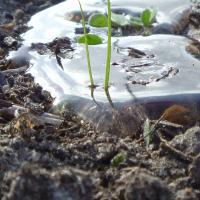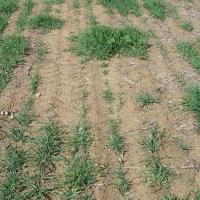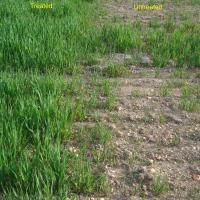Diagnosing water repellence
Water-repellent soils have waxes from organic matter on soil particles that cause them to resist the entry of water. After rain the soil typically remains dry except for a thin moist surface layer with scattered 'pipes' of wet soil in depressions or other places where water has pooled for long enough to overcome the repellence.
What to look for
- Patchy crop or pasture growth with failure to germinate in between.
- Dry patches of soil between moist depressions and in ridges between furrow sown crop.
- Drops of water form balls on dry soil and resist entry.
Paddock
- Staggered germination.
- Induced nutrient deficiency of soil-immobile nutrients, which become unavailable to the plant when the topsoil is dry. Phosphorus deficiency is common, as well as copper, zinc and manganese deficiency. These deficiencies are often transitory and disappear when rainfall rewets the topsoil.
Plant
Where does it occur?
- Coarse soils with low clay content are more susceptible to water repellence as the soil particles have less surface area to be coated by water-repellent waxes.
- Productive sandy soils in higher-rainfall areas tend to be more water repellent, as they produce more plant material to break down into organic matter.
- Two categories of water repellence are:
- 1. Soils that were highly water repellent before agriculture, such as the loamy brown mallet soils that occur below breakaways in the Great Southern district.
- 2. Sandy surfaced soils that have become water repellent due to a build-up of soil organic matter from agriculture. Water repellence is mostly confined to the topsoil.
Management strategies
- There are a range of treatments that vary in cost, reliability and duration of effectiveness.
- Furrow seeding is inexpensive and is effective on mild to moderately water repellent soils.
- On-row-seeding combined with low disturbance seeding is more costly but more reliable for mild to moderate water repellence.
- Banded wetting agent is an annual method particularly useful for dry seeding.
- Blanket wetting agent +/- water absorber is an effective short term practice for spraying strategic small zones and response will vary by soil type and product chemistry.
- One-way disc ploughing is a 3-5 years effective method for sandy earth, sandy gravel and gravels.
- Rotary spading is a 3-5 years effective method for deep sands, sandy earths and deep sandy duplexes.
- Mouldboard ploughing is a method for deep sands, sandy earths, sandy gravels and deep sandy duplexes that is effective for up to 10 years or more, and most valuable when weed seeds need burying.
- Clay delving or spreading is very expensive but effective for over 10 years. Some yield losses have occurred in dry patchy rain seasons in low rainfall years and areas.
How can it be monitored?
- As water repellence is concentrated in the topsoil the following tests are done in the top 3 centimetres of soil.
- 1. Time taken for a droplet of water to penetrate the soil.
- 2. The M.E.D. (Molarity of Ethanol Droplet) test measure the concentration of an ethanol solution required to penetrate the soil in under 10 seconds.
See also
Further information
Page last updated: Monday, 15 June 2015 - 3:14pm






